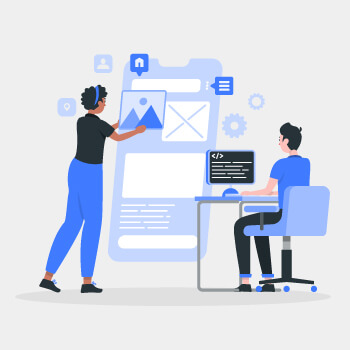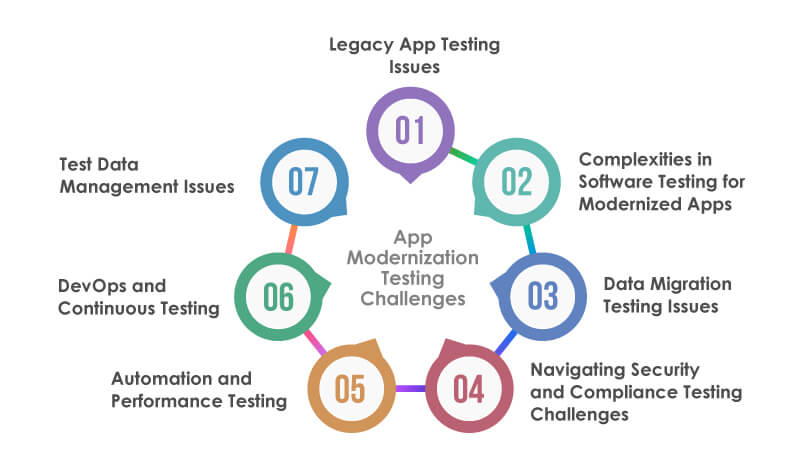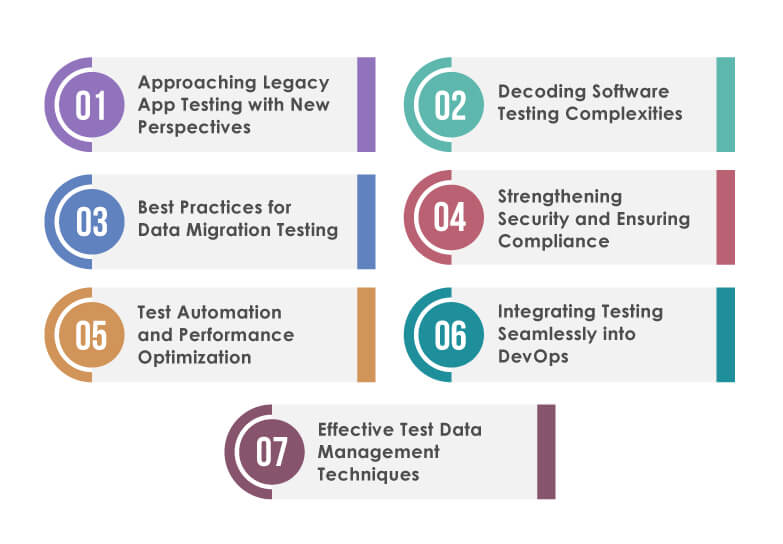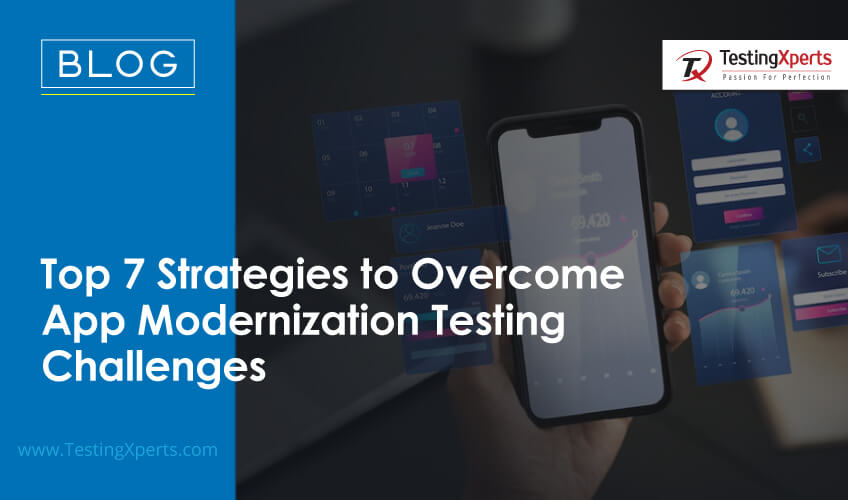- Why is App Modernization Testing Important?
- App Modernization Testing Challenges
- 7 Testing Strategies for App Modernization
- Conclusion
- Why Partner with TestingXperts for Application Modernization Testing?
The digital business landscape is rapidly changing, so the necessity of application modernization testing becomes increasingly critical. However, this process comes with challenges that must be taken care of. A staggering 87% of companies have adopted agile or agile-like software development models, emphasizing the shift towards more dynamic testing approaches. Moreover, 82% use exploratory testing, signifying the growing complexity and necessity for thorough testing methodologies.
The preference for programming languages like Rust and Python highlights the evolving technology stack, which brings its own set of testing challenges. Furthermore, with 78% of organizations employing test automation for functional or regression testing, the need for robust testing strategies in application modernization becomes apparent. Also, 44% of testing teams find it very challenging to be involved early in the project cycle, pointing to a gap in integrating testing seamlessly into the modernization process.
Addressing these testing challenges promptly and effectively is not just a technical necessity. It’s a strategic step for businesses aiming to grow in a digital-first economy.
Why is App Modernization Testing Important?

App modernization, the process of updating and improving existing legacy systems, is critical for businesses aiming to stay competitive in the rapidly evolving digital world. This modernization, however, brings with it the imperative need for thorough and effective testing. Application modernization testing ensures that new features and legacy system integrations function correctly, maintaining system integrity and performance. Modernization efforts can lead to unexpected outcomes, system downtimes, and user dissatisfaction without testing.
Thorough testing leads to higher quality products, fewer bugs, and reduced maintenance costs post-launch. It enables teams to address issues before they escalate, ensuring a smoother transition to modernized applications and better alignment with business goals.
App Modernization Testing Challenges

App modernization is crucial for businesses to stay relevant in the technology-driven market. However, transitioning from old systems to new, agile frameworks often encounter testing challenges that can hinder progress. Traditional testing methods may not suffice as applications become more complex and integrated with advanced technologies. QA engineers must manage various challenges, including outdated systems, complex architectures, and the expectation of continuous delivery.
Legacy Application Testing Issues:
Legacy applications, often built on outdated codebases, present significant testing issues. They may not easily integrate with new technologies, and their outdated design can result in unforeseen compatibility issues. Testers must ensure these applications continue functioning within modern frameworks without disrupting operations.
Complexities in Software Testing for Modernized Apps:
Modern applications operate in a layered technological environment, interfacing with cloud services, APIs, and various devices. This complexity requires a testing approach that can validate each layer’s functionality and interoperability, ensuring the application performs consistently across all platforms.
Data Migration Testing Issues:
Migrating data from legacy to modern systems is a delicate process. It’s necessary to maintain data integrity and accuracy. Testing must be thorough to prevent data loss or corruption and to ensure the new system correctly interprets the migrated data.
Navigating Security and Compliance Testing Challenges:
Modern applications must comply with many regulations and defend against evolving security threats. Testing must be comprehensive to cover all security aspects, from data encryption to access controls and ensure compliance with relevant laws and standards.
Automation and Performance Testing:
Automation is essential for efficient testing, but establishing automated testing procedures can be complex. Performance testing is crucial as it ensures the application can handle expected loads. Both areas require significant investment to overcome initial roadblocks, such as script development and performance bottleneck identification.
DevOps and Continuous Testing:
DevOps encourages a continuous integration and continuous delivery (CI/CD) model, which requires testing to be integrated into every stage of development. It shifts the focus from end-stage testing to continuous testing, which can be challenging to implement and maintain.
Test Data Management Issues:
Accurate test data is the backbone of effective testing. Managing this data (generating, maintaining, and securing it) becomes increasingly complex with the scale of modernization. Test data management must ensure the data is representative of real-world scenarios and does not expose sensitive information.
7 Testing Strategies for App Modernization

To address the above-mentioned challenges, the following are some of the strategic solutions that can help businesses streamline the application modernization testing process:
Approaching Legacy Application Testing with New Perspectives:
Legacy applications often lack the agility of modern systems, making testing a challenge. Overcoming this requires a fresh approach involving reverse-engineering to understand the existing functionalities, creating comprehensive documentation to fill in knowledge gaps, and identifying key integration points for new technologies. Testers must also innovate testing strategies by leveraging containerization to replicate legacy environments or utilizing service virtualization to mimic external interfaces. The goal is to create a testing environment that facilitates old and new systems, ensuring legacy applications deliver value throughout modernization.
Decoding Software Testing Complexities:
The complexity of modern software testing arises from the need to cover multiple platforms, devices, and integrations. Simplifying this process involves adopting a layered testing strategy that separates unit, integration, and user interface tests. Each layer can be tackled with specific tools and frameworks, such as xUnit for unit tests, Selenium for UI tests, and Postman for API testing. Moreover, implementing continuous testing in a CI/CD pipeline helps catch issues early and often. This approach requires a solid test plan that aligns with the architecture and design of the application.
Best Practices for Data Migration Testing:
Data migration testing is critical in verifying that data migration from legacy systems to modern platforms is accurate, complete, and secure. Best practices include:
• Thoroughly analyze the existing data structure.
• Mapping data fields accurately to the new system.
• Using ETL (Extract, Transform, Load) tools to automate the migration process.
Testers should perform trial migrations, verify data integrity, check for data loss or corruption, and conduct performance testing to ensure the new system can handle the migrated data. Moreover, involving stakeholders in validating business-critical data is crucial for the success of the migration.
Strengthening Security and Ensuring Compliance:
Security and compliance testing in the context of application modernization is an ongoing process that includes regular vulnerability assessments, penetration testing, and adherence to regulatory standards. Techniques for robust security testing involve using automated security scanning tools, such as OWASP ZAP or Nessus, to identify vulnerabilities early. Compliance is ensured by staying updated with the latest industry standards and legal requirements, such as GDPR for data protection or PCI DSS for payment security and conducting regular compliance audits. Embedding security practices within the DevOps pipeline ensures a secure development lifecycle.
Test Automation and Performance Optimization:
Automation is key to handling the increased pace and volume of testing in modern applications. The strategic approach to automation involves the following:
• Identifying repetitive, high-volume test cases for automation.
• Using tools like Selenium or Appium for UI automation.
• Employing performance testing tools like JMeter or LoadRunner.
This ensures a consistent and efficient testing process. Performance optimization is achieved by continuously monitoring application performance using APM (Application Performance Management) tools, analyzing bottlenecks, and optimizing code and infrastructure to meet performance expectations.
Integrating Testing Seamlessly into DevOps:
Integrating testing into DevOps involves embedding quality assurance processes throughout the development pipeline. This means automating test cases and including them in the CI/CD pipeline so that each integration triggers a test suite that provides immediate feedback. It requires a shift in mindset to view testing not as a separate phase but as an integral part of development, requiring close collaboration between developers, testers, and operations teams. Tools like Jenkins for CI/CD and test automation frameworks are crucial in achieving this seamless integration.
Effective Test Data Management Techniques:
Test data management ensures quality test data is available for testing processes. It involves techniques like data subsetting to create smaller, manageable versions of data sets, data masking to protect sensitive information, and synthetic data generation to produce data that mimics production data. It’s crucial to carefully manage the test data lifecycle, from creation to disposal, to ensure it remains relevant and secure. Test data management tools can help automate these processes, providing reliable data for testing while complying with data protection regulations.
Conclusion
In application modernization, the key to successful outcomes lies in robust testing strategies that are well-implemented and continuously improved. The insights represent the importance of strategic testing approaches, addressing everything from legacy system challenges to testing integration within DevOps practices. Businesses adopting these strategies improve performance, security, and user satisfaction. Staying updated with the latest testing trends will ensure that applications perform well today and are prepared for tomorrow’s technological advancements. The aim is to achieve a seamless modernization process that drives business growth and innovation.
Why Partner with TestingXperts for Application Modernization Testing?

In the digital era, where business agility and technological advancement are crucial, TestingXperts stands out as your ideal partner for app modernization testing. Here’s why you should partner with TestingXperts for app modernization testing needs:
• End-to-end quality assurance services tailored to support the full life cycle of app modernization. With our extensive experience in executing such modernization programs across various geographies, we bring a unique global perspective and expertise.
• With over 350 devices in our mobile test lab, we guarantee comprehensive testing across all user scenarios. We also have access to hundreds of devices over the cloud through our partners like BrowerStack.
• Leveraging cutting-edge tools, we conduct functional, performance, and security testing, elevating the efficiency and reliability of our processes.
• Specialization in validating data integrity during migrations, with customized strategies and advanced automation capabilities.
• Our approach to test data management encompasses industry-leading practices and tools, ensuring high-quality testing for complex and large-scale projects.
To know more, contact our QA experts now.
The post Top 7 Strategies to Overcome Application Modernization Testing Challenges first appeared on TestingXperts.





